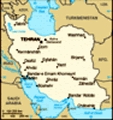Advertisement
Published: July 19th 2017
My soul is from elsewhere, I'm sure of that, and I intend to end up there. - Rumi
Passenger trains in Iran generally run overnight between major cities, a perfect travel solution when you’re on an independent journey because you save the expense of a hotel while getting to experience the best way humanity has invented to travel overland. When you’re on a tour you spend the day taking the bus, like we did – six hours to Yazd with one stop to stretch our legs. No tea for me, please. To be fair, the journey was lovely, passing through the eastern section of the Zagros mountain range where we experienced snow flurries, flocks of goats and sheep and distant snow-covered peaks on our way towards Yazd, the driest major city in Iran as well as one of the hottest, surrounded by two deserts, the Dasht-e-Kavir and the Kavir-e-Loot. Possibly the oldest living city on Earth, Yazd has been continually inhabited for the past 7,000 years. Because of its geographic extremes it has developed some wonderfully inventive and evocative architecture, which was one of our main reasons for visiting, along with its long history and unique link to

 Bus Ride to Yazd
Bus Ride to Yazd
*photo courtesy of Clementthe Zoroastrian religion.
Even before we arrived I was fascinated by Zoroastrianism, the world’s first monotheistic religion which strongly influenced Judaism and later Christianity and Islam. The core of Zarathustrian teaching is to honor the one true god, Ahura Mazda, by choosing truth and avoiding lies, and always striving for good words, good thoughts and good deeds. The largest Zoroastrian population now exists in India, where they are known as Parsis, but Iran is said to have around 25,000 practicing Zoroastrians, with more converts as people rediscover their pre-Islamic heritage.
We arrived in the early afternoon at the Silk Road Hotel, extremely atmospheric and highly recommended, and enjoyed a late lunch of yogurt, koresht bademjan, beef stew, doogh and rose water. Our tour of the city commenced with a stroll through the Old City, where our hotel was located, with quiet twisting lanes, water reservoirs, wind towers, on the way to the beautiful Jame Mosque. Built in the 15
th century, it's on the site of a 12
th century building believed to have itself replaced an earlier fire temple. Quick jaunt to Alexander’s Prison – not a highlight – past the 11
th century Tomb of the Twelve Imams, in
which no imams are buried. Nighttime view of Tekiye Amir, where the government has recently, and controversially, buried the remains of unknown soldiers, on the way to Saheb A Zaman Club Zurkhaneh. An athletic performance and cultural experience, with groups of men performing ritualized feats of strength and whirl dervish-like to the accompaniment of a pounding drum. These wrestlers used to provide protection to the people against the establishment and thus were targeted under the Shah, with many casualties, but today there is a revival of the art. This modern club is inside a large water reservoir from the late 1500s, and you can still climb downstairs to see where much of the town's water was once stored. Late evening relaxation in hotel courtyard over dates with tea and saffron sugar.
Our second day in Yazd began outside the town at the Zoroastrian Towers of Silence, actually two large mounds, one now fitted out with a staircase, where the bodies of the Zoroastrian dead would be laid out to be eaten by vultures and the remains rendered into nothing by the use of acid in a central pit. These methods were last used in the 1960s. The Zoroastrian Fire

 Tekiye Amir
Tekiye Amir
*photo courtesy of ClementTemple, a lure for Zoroastrians around the world and our next stop, was built in the Indian style and houses a flame that has been burning continuously for at least the past 1500 years, originally constructed from 16 different fires and consecrated in a year-long ceremony. Next to the temple was a small museum. Today it was overrun by a raucous group of Iranian schoolboys, each vying for our attention with incessant cries of “hello, hello!”.
Back in the Old Town we visited the Yazd Water Museum, located in a lovely restored mansion, and the Khan e-Llaari – a wonderfully preserved Qajar-era house where we felt the cooling wind towers in action – before a peaceful rooftop lunch at the Art House – good food but extremely slow service.
Two of the most important and unique features of Yazidi desert architecture are qanats and bagdirs. Qanats, or underground water channels, have been used by Iranians for at least 200 years to irrigate crops and gardens and supply drinking water. Relying on gravity to function and requiring highly skilled (and brave!) workers to build and maintain, these expensive and essential pieces of desert technology are governed by extremely complex
laws and customs. Iran is thought to have more than 50,000 qanats, and many desert towns and villages still rely upon them for their existence. Bagdirs, or wind towers, are ancient systems of air-conditioning that catch even the slightest breeze and direct it to the rooms below, often above a pool of cool water. Refreshing and healthy.
In the afternoon we enjoyed tea in the hotel courtyard and a brief rest before an early evening exploring the bazaar and buying some famous Yazidi confections, such as saffron candy floss. Cardamom tea with dates and pistachios before bed.
Advertisement
Tot: 0.125s; Tpl: 0.016s; cc: 10; qc: 46; dbt: 0.0668s; 1; m:domysql w:travelblog (10.17.0.13); sld: 1;
; mem: 1.1mb























